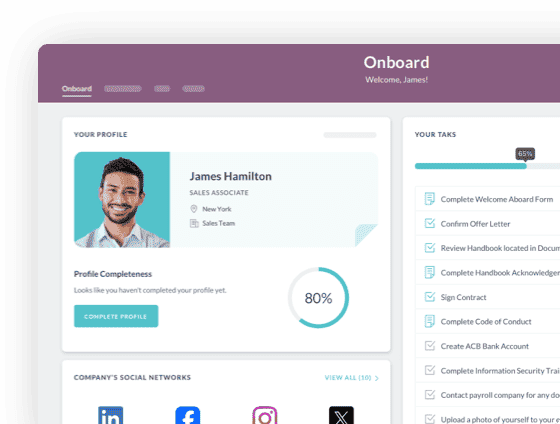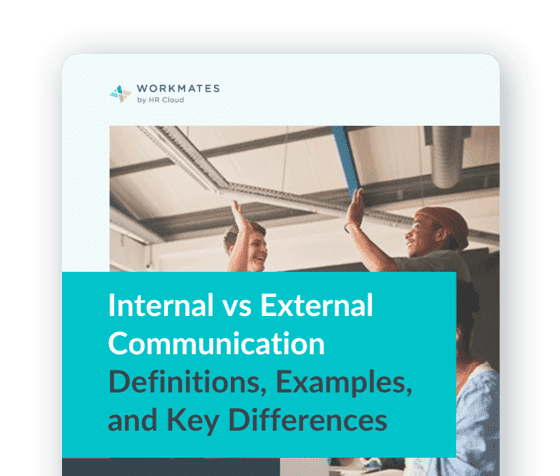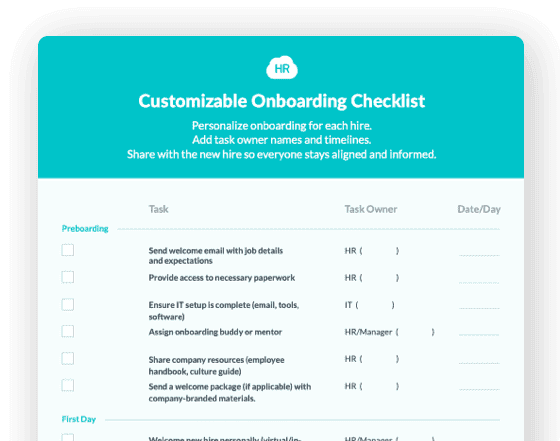- #1 Create Onboarding SOPs
- #2 Comprehensive Induction & Training
- #3 Communicate Strategic Role Of Outsourced Employees Clearly To Inhouse Employees
- #4 Foster Relationship Building Between Outsourced & Permanent Employees
- #5 Make Outsourced Employees Feel As Much A Part Of The Organisation As Permanent Employees
- Conclusion


 Cut onboarding time
by 60%—here's the
Ultimate Checklist
that helped do it.
Cut onboarding time
by 60%—here's the
Ultimate Checklist
that helped do it.

In the modern economy, countless firms leverage outsourcing for added flexibility in their business processes. In 2022 most corporations, and many SMEs, make use of outsourcing to some extent, especially across roles like IT where technologies and needs can change quickly depending on the market and project cycles.
But outsourcing has to be well managed by an organisation for it to be leveraged to full advantage. You can’t parachute outsourced staff into your organisation and expect that to work out any better than you would if hiring in-house staff with no onboarding process.
Outsourced staff are, by nature, temporary. They might be with an organisation for just a few days; or years. But the no.1 reason why companies outsource functions is that there is a lack of long term clarity around the length of time certain staff and specialists might be required for; or that it is clear they will only be required for a particular period.
Being able to scale employee numbers up and down with projects and other cycles that mean elastic requirements can be a significant strategic advantage. But the quality of the work of outsourced staff should meet the quality you would expect from permanent employees for the strategy to be sustainably successful.
With that in mind, there are three compelling reasons why a strong onboarding process is necessary for outsourced employees:
-
An onboarding process is necessary for any employee, in-house or outsourced.
-
Good onboarding experience is particularly important for outsourced employees because they will contribute for a time-boxed period, which means it is particularly important they are brought up to speed and integrated quickly and effectively.
-
A strong onboarding process reduces the threat of tensions between permanent in-house employees and outsourced employees.
The onboarding checklist of outsourced employees won’t necessarily always be the same. A software development team from an IT outsourcing provider will need to pass through an onboarding process that looks different to that for service desk staff. But there are a number of universal principles and steps that almost any onboarding process for outsourced staff should incorporate.
Let’s Run Through 5 Of These Steps:
#1 Create Onboarding SOPs
A well thought out and clearly defined onboarding plan that has been tailored to different outsourced functions within your organisation is key to both the quality and consistency of integrating outsourced employee experience. To achieve that make sure you create detailed SOPs (standard operating procedures) that can be followed as steps and checked off as each is completed.
That will ensure every outsourced employee passes through an effective onboarding process which will give them the best chance of settling quickly into their role and excelling on behalf of your organisation. It also introduces trackability and accountability so the source of any onboarding failures can be identified and rectified.
#2 Comprehensive Induction & Training
There can be a reluctance for employers to invest the same amount of effort into inducting and training outsourced team members as they would in-house staff on permanent contracts. While it is logical to particularly invest in team members you expect to be with you for the long haul, it is also important to not cut corners with outsourced staff.
The reason you are making use of outsourced staff is because you need them as per your project management plans. Unless there is a clear reason why the quality of the execution of that function is less important than it would be if you were using permanent employees, outsourced employees should be given the same level of induction and training.
Any drop in the quality of the work performed by outsourced employees due to a lack of training or induction processes will reflect just as poorly on your organisation as it would if they were permanent staff members. Nobody from outside the organisation will make a distinction between outsourced and permanent employees.
And your permanent employees won’t either if working with outsourced colleagues. If they underperform in a way that impacts the work of others because they weren’t given comprehensive enough inductions and training, you’ll negatively impact the sentiment of your permanent workforce.
#3 Communicate Strategic Role Of Outsourced Employees Clearly To Inhouse Employees
Part of the onboarding process of outsourced employees should involve permanent, inhouse employees. You should communicate clearly why these roles are being outsourced and why that strategic decision is in the interests of the organisation and, by extension, all of the permanent staff.
This stage is especially important if outsourced employees fulfil functions that were previously executed by permanent inhouse employees. And particularly if permanent employees fulfilling those functions have been recently let go. That could lead to an “us and them” culture between permanent and outsourced team members that is corrosive to working relationships and outcomes.
Even if new functions that have never been executed in house are being fulfilled by outsourced employees, communicating why those functions, and reassuring permanent employees there are no plans to subsequently outsource their jobs, is important to cohesion.
#4 Foster Relationship Building Between Outsourced & Permanent Employees
Not all outsourced employees will fulfil functions that bring them into regular contact or collaboration with permanent employees. But many will and in those cases a central part of the onboarding process should be focused on establishing relationships between new outsourced staff and permanent employees already working for the company.
Creating an environment and potentially activities conducive to helping foster personal relationships between outsourced and permanent staff who will be working together will help more quickly forge a new collective working effectively towards the same goals.
#5 Make Outsourced Employees Feel As Much A Part Of The Organisation As Permanent Employees
Whether an employee is outsourced on a permanent inhouse contract, effort and performance will almost certainly be maintained at a higher level if professionals have bought into what your organisation is trying to achieve and feel part of it. If less effort is made to introduce outsourced employees to company culture, the workplace community and explain the aims, goals and intended outcomes of their work, the likelihood is they will put less into it.
If outsourced employees feel like hired guns brought in to do a job then leave and be forgotten about, they are unlikely to be as vested in that as starting a new job. How well-outsourced employees can be integrated into your organization and with colleagues who are permanent employees will inevitably be influenced by how long their contracts run. But if outsourced staff will or are likely to be working within your organization for a medium to long-term basis, it is just as important they feel part of the organization, and are as invested in its success, as anyone else.
Conclusion
The dynamism of the modern economy makes it more crucial than ever for organisations to be flexible and able to quickly adapt to a changing environment. Using outsourced employees for functions that might need to be scaled up or down through time or with project cycles is one of the most effective ways for an organisation to introduce that flexibility into its workforce.
However, a poorly managed approach to outsourcing can undo much of the strategic benefit the staffing model can bring. Establishing a high quality and consistent outsourced employee onboarding process is one of the best ways an organisation can ensure that it leverages the advantages of outsourcing without falling victim to its potential downsides.
The five important steps outlined here will need to be adapted to your particular circumstances and the roles you are outsourcing. And you will need to break them down into smaller steps that form part of a detailed SOP. But if you make sure all five are suitably addressed by your onboarding process for outsourced employees, you will have a strong foundation which should mean you realise the maximum benefit and minimal downsides.
About Author: This article is written by our marketing team at HR Cloud. HR Cloud is dedicated to providing powerful solutions for your HR teams and creating an exceptional employee experience. Our aim is to help your company improve employee engagement, onboarding, and to save you valuable time!
Keep Reading
The Hidden Metrics of Frontline Success: Beyond Engagement Scores
"What gets measured gets managed, but what gets measured well gets transformed." — Peter
Embracing Diversity: Recognizing Different Cultures in the Workplace
Workplaces today reflect the incredible diversity of the world around us. People bring
From Manual to Automated: A Complete Guide to Digitizing Employee Onboarding for Large Organizations
Sarah Chen, Director of HR at a 7,000-employee healthcare organization, starts her Monday
Like What You Hear?
We'd love to chat with you more about how HR Cloud® can support your business's HR needs. Book Your Free Demo

Build a Culture of Recognition. Boost Engagement. Guaranteed.
Workmates empowers employees to stay informed, connected, and appreciated—whether they’re on the front line, in the office, or remote. Recognition drives 12x higher engagement.Trusted by industry leaders in every sector




Cut Onboarding Costs by 60%.
Take the confusion and follow-ups out of onboarding with automated workflows, digital forms, and structured portals—so new hires ramp faster 3X quicker.Trusted by industry leaders in every sector




.jpg)
